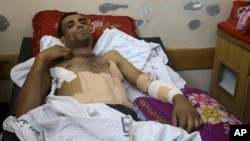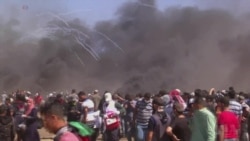Marwan Shtewi is poor, unemployed and at the age of 32 has never left the Gaza Strip.
With few prospects and little to fear, Shtewi is among the crowds of young men who put themselves on the front lines of violent protests along the border with Israel, risking their lives in a weekly showdown meant to draw attention to the dire conditions of Gaza.
While protest organizers voice slogans of defending Jerusalem and returning to the lost homes of their forefathers in Israel, it is the desperation among young men like Shtewi that has been the driving force in the demonstrations. Recovering from a gunshot wound to his arm that sent shrapnel into his abdomen, Shtewi says his protest days are now behind him and he only dreams of finally finding a job.
“I want to see peace and hope and prosperity spread in Gaza when I get out of the hospital,” he said from his hospital bed.
WATCH: Palestinian Official: US Ambassador to UN Is Not World's Schoolmarm
Bleak Gaza
The Hamas-led organizers of what they called the Great March of Return initially billed the six-week protests as a call to break through the border fence and return to homes that were lost 70 years ago during the war surrounding Israel’s creation. Two-thirds of Gaza’s 2 million people are descendants of refugees who either fled or were forced from their homes.
But most protesters say they are simply driven by desperation caused by a decade-long blockade imposed by Israel and Egypt after the Islamic militants seized power from the internationally backed Palestinian Authority in 2007.
Israel says the blockade is needed to prevent Hamas, which seeks Israel’s destruction, from building up its military capabilities.
The blockade has largely sealed Gaza’s borders, greatly limiting the movement of people and goods in and out of the territory. The rival Palestinian Authority, based in the West Bank, has added to the pressure by cutting salaries to its former workforce and limiting electricity transmission.
The results are staggering. Gazans receive only several hours of electricity a day, unable to predict when power will come on. Tap water is undrinkable, and the Mediterranean beachfront smells from the tons of untreated sewage dumped into it each day. Unemployment is more than 40 percent, and among young men like Shtewi, joblessness is nearly two-thirds.
Bored and disaffected
The difficult conditions have created a seemingly endless pool of disaffected young people ready to square off against the Israeli snipers over the border.
Tens of thousands of people have joined the gatherings each week. Most keep a safe distance from the border fence, but small groups of young men have pushed to the front lines to snip off pieces of the structure with wire cutters, or hurl flaming tires, firebombs and stones toward the Israeli troops.
Shtewi said he sometimes throws stones or sets tires on fire, but most of the time he just stands there to kill time.
“The protests are a new way to break the boredom,” he said.
He said it’s easy to get caught up in the excitement and try to damage the fence. But, he added, “sometimes fear overwhelms me, and I hide behind people because I’m afraid of being shot.”
Hundreds dead or wounded
Israeli gunfire has killed more than 110 Palestinians and wounded hundreds more since the protests began March 30. On Monday, 59 people were killed in the deadliest day of cross-border violence since a 2014 war between Israel and Hamas. Shtewi was among some 1,300 others wounded by live fire.
With his left arm and abdomen covered in bandages, he struggled to remember what happened when he was shot.
“I went with the youths and was almost at the fence. There was random shooting and tear gas,” he said. “A jeep came and fired tear gas. I was hit. I don’t know how and when I ended up here.”
The high casualty count has drawn international condemnations against Israel and accusations that it is using disproportionate force. Just one soldier has been wounded.
Role of Hamas
Israel accuses Hamas of exploiting civilians and putting them in harm’s way by encouraging them to rush the fence. It also says the militants are using the large crowds and thick black smoke as cover to plant bombs, fire at troops and try to break through the border to carry out attacks.
Shtewi said he does not belong to Hamas and has not received a cent from the militant group, though other activists say they have received food or small sums of money to gather tires.
He also said that he went to the protests without telling his parents or fiancee because they would object.
“If I knew, I would have barred him,” said his mother, Fatma. “I lost my mind and ran out of the house when I learned about his injury because I thought he was martyred.”
Solution: a job
Shtewi grew up in Zeitoun, a hardscrabble neighborhood on the southern outskirts of Gaza City. Like many Gazans, Shtewi has never set foot outside the 25-mile-long (40-kilometer-long) strip of land. He was 21 when Hamas seized power, and under the blockade, both Israel and Egypt tightly restrict travel through their borders.
Shtewi scrapes by with occasional work as a porter or day laborer. He said his dream is to immigrate to the United Arab Emirates, where his family once lived. He said he hears “there are good job opportunities there.”
But for now, he said he just wants to find a job that will provide him enough money to get married. He still lives in his childhood home with his parents and five siblings. Some of his brothers are married and also live in the home with their children, each family in its own bedroom.
Like most Gaza residents, Shtewi directs his anger at Israel. In December, he participated in protests when President Donald Trump recognized Jerusalem as Israel’s capital. Last summer, he was wounded in the leg by Israeli gunfire during Gaza protests against Israel’s installation of metal detectors at Jerusalem’s Al Aqsa Mosque, in response to the killings of two police officers.
This week’s shooting was far more serious. As he spoke, he pointed to IV tubes attached to his arm and asked his older brother, Fathi, when he would be released.
“Soon, God willing,” his brother responded. Later, the brother whispered to their mother that an X-ray showed severe chest inflammation and it is unclear when he can be discharged.
Leaning against the wall, the older Shtewi said the solution is clear. People need work.
“When there is work, people will keep themselves busy and we will not see all of this anymore,” he said.














